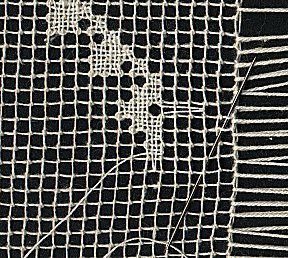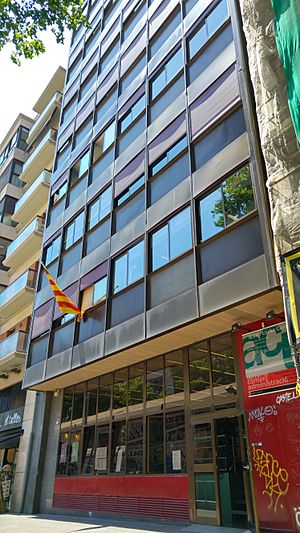Adelaida Ferré Gomis facts for kids
Quick facts for kids
Adelaida Ferré Gomis
|
|
|---|---|

(192?)
|
|
| Born | February 24, 1881 Barcelona, Spain
|
| Died | March 9, 1955 Barcelona
|
| Alma mater | Municipal Conservatory of Barcelona |
| Known for | historian, teacher, and folklorist associated with lace-making in Catalonia |
Adelaida Ferré i Gomis de Ruíz de Narváez (born February 24, 1881, died March 9, 1955) was a Spanish historian, teacher, and folklorist. She was especially known for her work with lace-making in Catalonia, Spain.
Contents
Adelaida's Early Life and Learning
Adelaida Ferré Gomis was the daughter of Pere Ferré, a painter and decorator. She started her education at the Escola Normal Superior de Mestres. Later, she went to the Municipal Conservatory of Barcelona. She also studied at the Escola d'Institutrius. There, she learned from the famous folklorist Rossend Serra i Pagès.
Between 1902 and 1915, Adelaida also studied art at the Escola de la Llotja. She combined her art studies with learning at other places. These included the ca:Institut Català de les Arts del Llibre and the Centro de Cultura de Mujeres Francesca Bonnemaison. At these schools, she became very skilled in making lace and other crafts. One of her teachers, José Fiter e Inglés, sparked her interest in the history of needle lace.
Adelaida's Career and Work
Adelaida's artworks were shown in important exhibitions. For example, in 1910, her work was part of the Exposición de retratos y dibujos antiguos y modernos. This show took place at the Palau de les Belles Arts in Barcelona. She also took part in the Exposició d'Art de Barcelona in 1920. The next year, she was in the Exposició de ferros artístics.
Adelaida loved to teach both crafts and art. She taught artistic drawing and engraving. She also taught modeling and art history. She even taught classes on embossed leather. A big part of her career was at the Municipal School of Trades for Women. This school was later renamed the Lluïsa Cura School.
Starting in 1911, she taught embroidered lace and needle lace there. In 1942, she became the school's director. She retired after ten years in that role.
Adelaida was very keen on sharing knowledge. She did a lot of research on textile activities, especially lace. She didn't just teach in classrooms. She also gave many talks and wrote articles.
Adelaida: The Historian of Lace
Adelaida Ferré is known as the historian of lace in Spain. When she started studying this art, there wasn't much written about it in Catalonia. Her early studies appeared in magazines like Joventut and Art jove. She also wrote for La Veu de Catalunya.
From 1931 to 1948, her main studies were published in the Butlletí del Museu d'Art de Barcelona. She helped this museum by documenting its textile collection. Her research provides valuable information. It helps us understand the history of textile production in Catalonia and beyond. She also helped organize the collections of Barcelona's art museums.
Adelaida knew a lot about bobbin lace. She studied its past and how it was made in her time. She looked at its techniques, history, and even the special words used for it.
Like other famous folklorists, Adelaida was interested in Esperanto. This is an international language. In 1909, she took part in the fifth international congress for this language. It was held in Barcelona.
Adelaida's Lasting Impact
Today, Adelaida Ferré is remembered for helping start the ca:Escola de Puntaires de Barcelona. This is a school for lace makers. As director of the Lluïsa Cura School, she asked the sisters Antònia and Montserrat Raventós Ventura to teach lace classes.
Adelaida also worked closely with the Fomento de las Artes y del Diseño. She was also connected to the Centre Excursionista de Catalunya. Her writings and research are kept in places like the Fishing Museum, Palamós and the Library of Catalonia. The Marès Lace Museum has two examples of bobbin lace. Adelaida designed these, and they were made by ca:Clotilde Pascual i Fibla. They were shown in an exhibition in 1918.
See also
 In Spanish: Adelaida Ferré Gomis para niños
In Spanish: Adelaida Ferré Gomis para niños





